Environmentalists see red since they feel that survival chances of the around 200 relocated trees are merely 30 percent.
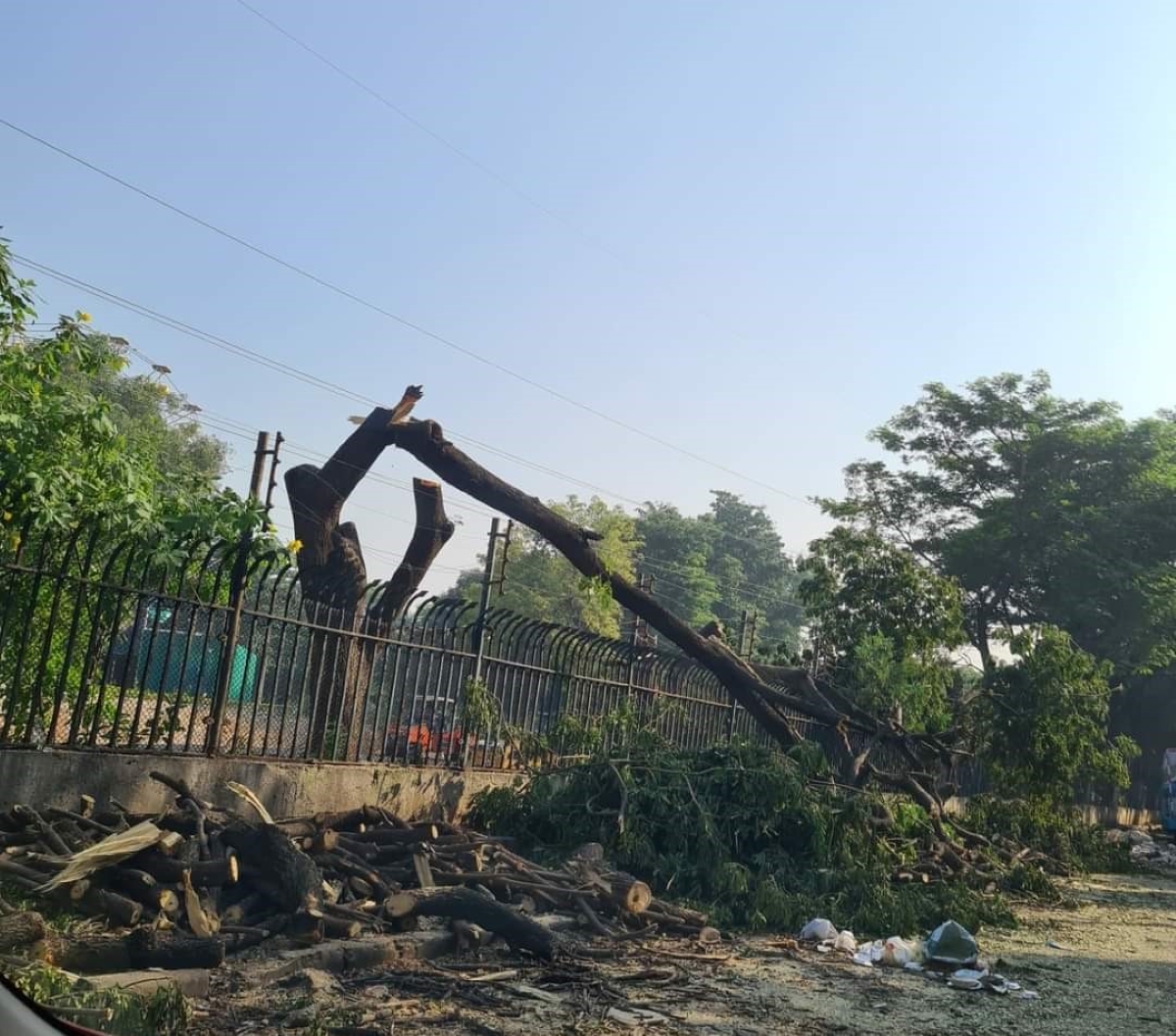
A tree at the NTR Marg
Call it irony in the fast lane!
Hyderabad, the winner of the “World Green Award”, is busy pruning and relocating around 200 healthy trees dotting the NTR Marg to hold Formula E, “founded to counteract climate change by accelerating the adoption of electric vehicles”.
Environmentalists termed the Hyderabad Metropolitan Development Authority (HMDA)’s move to relocate the trees to NTR and Sanjeevayya parks “ironic”. The trees are being relocated to meet the prescribed width of the racing track.
They have a reason to term it ironic. The event is an environmentally sustainable one to demonstrate the potential of electric vehicles and alternative energy solutions to reduce dependence on fossil fuels coming at the cost of removing trees.
Translocation of trees is a process in which a whole tree is uprooted, instead of being chopped down, and re-planted at a different location.
About 200 much-loved Trees of Gold have been removed for Formula E race tracks on NTR Marg, Hyderabad. A mere 78 trees of gold have been left standing.
The is tragic and ironical
in a city that just won a green award.When will this madness stop?#hmda #KTRTRS #KCR pic.twitter.com/dbAlAIqSnq
— Save Banyans of Chevella (@chevellabanyans) November 8, 2022
The HMDA’s move has now become a controversy. It comes close on the heels of the city bagging the “World Green City Award 2022″, constituted by the International Association of Horticultural Producers (AIPH).
“These international awards are proof that the state government is strongly implementing the Haritaharam and urban development programmes… giving green fruits to the country. It is a matter of pride that Hyderabad is the only city from India to be selected for these international awards,” Telangana Chief Minister K Chandrasekhar Rao said of the award.
When South First visited NTR Marg, shopkeepers and residents said that several trees were removed over the past few days. Construction of the track is on at a brisk pace. At some places, new saplings are being planted.
The race is scheduled for 11 February, 2023. A 2.37-km racing track is being prepared around the Hussain Sagar Lake as per the guidelines of the Fédération Internationale de l’Automobile, which also holds Formula 1.
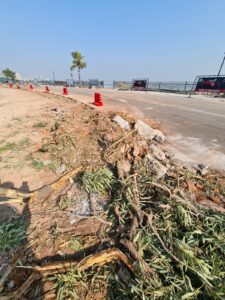 The relocation of trees has angered the greens. Terming it “impractical”, the environmentalists demanded the government to check the survival data of such trees.
The relocation of trees has angered the greens. Terming it “impractical”, the environmentalists demanded the government to check the survival data of such trees.
“During a transplantation or relocation of a tree, the chances of survival are around 30 percent. In some cases, it’s even lower. And even after 30 percent survival, the tree demands intensive care,” Natasha Ramarathanam, a member of the city-based citizen’s group known as Nature Lovers of Hyderabad, told South First.
Drawing attention to the Central Vista Project in Delhi, she added that only 27 percent to 30 percent of trees survived after a year.
According to overall data on tree transplantation submitted by the Forest Department to the Delhi High Court in May this year, of the 404 trees transplanted for the “Proposed Expansion and Restoration of the Existing Parliament Building at Plot No 118,” part of the Central Vista project, only 121 (30 percent) have survived.
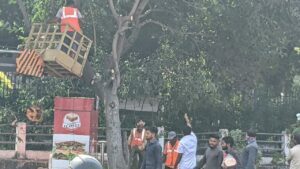 “This was the result even after all elaborate planning. In Hyderabad, it happened very fast”, Ramarathanam said, adding that not much could be done now as the Tree Protection Committee (TPC) has approved the removal of the trees.
“This was the result even after all elaborate planning. In Hyderabad, it happened very fast”, Ramarathanam said, adding that not much could be done now as the Tree Protection Committee (TPC) has approved the removal of the trees.
Speaking about the trees that were pruned and translocated, she said, “It will take two to three years for branches to sprout and flowers to bloom again.”
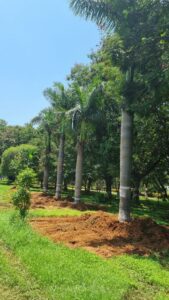 Aghast at the move to translocate trees, the Nature Lovers of Hyderabad took to social media, terming the move “ghettoisation” of trees.
Aghast at the move to translocate trees, the Nature Lovers of Hyderabad took to social media, terming the move “ghettoisation” of trees.
“Hyderabad’s parks are not ‘tree ghettoes’ — in the future, should we expect to see trees only in parks? Will roads only have shrubs and small trees that can be removed and put back like lawn grass,” the organisation wondered.
“It is a big thing that Formula E came to Hyderabad and we are proud of it. But why it is not conducted near Shamshabad or the Outer Ring Road (ORR) where there are fewer trees”, Ramarathanam asked.
She noted trees are the biggest defense in holding down particulate matter when air pollution in Hyderabad — India’s fourth-most polluted city — is on a high.
“Forget the aesthetic value of a tree”, she continued. “There is a lot of economic value when trees work against carbon emissions. They were over a decade old and each of them would have taken in a lot of carbon. Translocation is not bad but needs to be prepared months in advance. Relocating 200 trees could not be done in two days”.
The environmentalists demanded that the government should ensure compensatory afforestation.
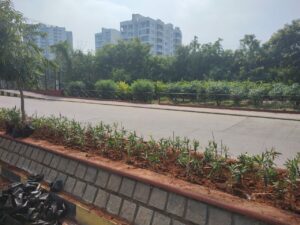 “Those 200 trees should be replaced with at least 1,000 trees. That means five new plants per one relocated tree. That’s what Bengaluru did,” Ramarathanam pointed out.
“Those 200 trees should be replaced with at least 1,000 trees. That means five new plants per one relocated tree. That’s what Bengaluru did,” Ramarathanam pointed out.
She added that native species should be the replacement and not eucalyptus, bamboo, or some other tree, with not much ecological value.
Terming the government’s decision to relocate the trees “whimsical”, Ramarathanam demanded the authorities to facilitate a proper discussion.
“But it will not happen as civil societies do not demand an answer,” she rued.
Vijay Nishanth, a Bengaluru-based urban conservationist and a tree doctor, told South First: “When the government wants transplantation, its first responsibility is to see how many people want it. The reasoning should be solid to convince people.”
Relocation, he added, should be conducted after a proper examination of the tree, taking into account its health and age.
Meanwhille, the State Department of the Municipal Administration and Urban Development noted on social media that translocation of “certain minimum number of trees became inevitable” to widen the track.
“About 2/3rd of the trees affected are small-sized and another 30% are medium-sized and only about 10% (including royal palm trees) are large trees,” it added.
Concerned citizens have pointed out about the removal of trees on a Road adjacent to Secretariat. Officials at @TSMAUDOnline have informed that all precautions were taken and these trees were translocated to NTR Garden & Sanjeevayya Park.
Photos of transplanted trees 👇 https://t.co/I8VrpKApFt pic.twitter.com/rWABrY8UKf
— Konatham Dileep (@KonathamDileep) November 8, 2022
While justifying the relocation of most trees to NTR Garden and Sanjeevaiah Park, it added: “The survival rate after the translocation is 100%. State Govt. is committed to protect the green cover and minimise dislocation [sic].” The department said that the remaining trees would be translocated in similar fashion.
About the pruned trees, the department assured that they will be in full bloom in the next four months.

Apr 20, 2024

Apr 20, 2024

Apr 20, 2024

Apr 20, 2024

Apr 20, 2024